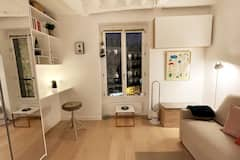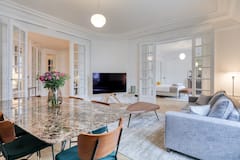National Residence of the Invalids, Les Invalides in French, is among the foremost landmarks of the French capital, credited for its historical comprehensiveness and architectural diversity.
It wouldn’t even be exaggerated to say that each part of the complex is unique in some way, which you are about to find out. There are areas that can be accessed for free within the National Residence of the Invalids, while for the others certain fees apply.
Historical overview of the National Residence of the Invalids

The beginnings of this exceptional complex are related to Louis XIV, the legendary French king, who felt sorry for his disabled soldiers who had nowhere to live nor any means for survival. So instead of the barracks that were planned to be established here, he commissioned the residence for disabled soldiers, hence the name of the establishment.
The National Residence of the Invalids was completed in 1676, five years after the foundations were placed. The next step was the expansion of the residence with a religious building. Being profoundly religious, Louis XIV required the residents to attend the services, which they couldn’t attend elsewhere for obvious reasons. This is why the Saint Louis Church, also referred to as the Soldiers’ Church, came into existence in the next three years. Another significant acquisition followed, and the marvellous Royal Chapel was completed in 1706.
Being the soldiers’ residence, the National Residence of the Invalids was laden with weapons of various types, and on the eve of the French Revolution (1789 – 1799) the revolutionists broke in and confiscated any piece of weaponry they could find. Equipped with tens of thousands of guns and rifles, and dozens of cannons, they marched on the Bastille. Being looted and heavily damaged during the occasion, the National Residence of the Invalids was left to decay until Napoleon Bonaparte (Napoleon I) had it refurbished and set for various significant ceremonies and official receptions in the first half of the 19th century.
The Saint Louis Church (the Soldiers’ Church)

The uniqueness of the Saint Louis Church isn’t related to opulent decoration or spectacular artwork. If you take a closer look at the related photo, you’ll surely notice the various types of flags. Being a military church, it somehow stands to reason that it was used for storage of captured flags and other trophies taken from the defeated enemies throughout European battlefields during the 18th century and the Napoleonic Wars. The Saint Louis Church is the only church where military trophies are displayed.
For non-Christian visitors who wish to find out more about the passion of Christ, the artwork in the church illustrates his way to Golgotha, while carrying the wooden cross he was about to be crucified on.
The admission to the church is free.
The Dome Church

The Dome Church, designed by Jules Hardouin-Mansart – one of Louis XIV’s leading architects - appeals with its grandiose architecture. On sunny days, the reflection of the sunlight from the dominant cupola draws as much attention to the building as anything else. The Dome Church is one of Mansart’s masterpieces, which is 107 meters (351 ft) tall.
Featuring classical elements, such as two orders with Ionic and Corinthian columns and a pediment, the edifice is the crowning example of the French Baroque style. The oval cupola features golden floral decorations, which reflect the sunlight, and is topped by an equally gilded lantern with a spire.
From the inside, the cupola’s artworks illustrate the twelve apostles and King Louis IX, who hands his sword over to Jesus Christ to use against the infidels. The Dome Church, which is connected to the Saint Louis Church, used to be a Royal Chapel, from where the royalty entered the Saint Louis Church during religious services.
You might be interested in these Airbnbs!
Tomb of Napoleon Bonaparte

The tomb of one of the most illustrious Frenchmen is located in the sub-level, beneath the cupola. Being held prisoner on Saint Helena Island, where he died in 1821, Napoleon Bonaparte’s remains were retrieved by the French state in the late 1830s. When the remains finally arrived in Paris, the entire city was on the streets during the snowstorm in September 1840 to honour the Emperor and attend the funeral.
A huge sarcophagus occupies the centre of an oval gallery, surrounded by twelve Winged Victories that symbolize Napoleon’s most significant victories on various battlefields. You can easily read where these victories were won as you circle the gallery. Besides being a brilliant military commander, Napoleon I was a reformer, too. His numerous reforms are illustrated by bas-reliefs.
The Dome Church is also an eternal resting place for two of Napoleon’s marshals and his brother Jerome. His son, Napoleon II, who barely reached adulthood, is also buried here. His remains were transferred from Vienna by orders of (you would never guess) Hitler in 1940.
Military Museum of the National Residence of the Invalids

The world’s most comprehensive Military Museum occupies the neighbouring building, probably covering the entire history of warfare, not only of France, but of the entire world. As you advance from one section to another, you’ll become familiarized with the development of weaponry through the ages, adjustment of battle tactics and strategies, numerous models and real weapons, and more.
The exhibition is accompanied by personal objects of various conquerors and significant personalities (Turkish sultan Bayazet II’s helmet, for example), complete war equipment of Japanese samurais, and many more.
Useful information
The National Residence of the Invalids’ courtyards and the Saint Louis Church can be accessed for free, while admission fees apply for the Dome Church and the Military Museum. The best value is provided by the Paris Museum Pass, or any similar Paris city card, which allows free entrance. Unlike most other top tourist attractions in Paris, the National Residence of the Invalids isn’t crowded. Operating hours are between 10 am and 6 pm (April - end of October) and 10 am and 5 pm (November - end of March), and a full price ticket costs 11 EUR (12 USD).
History
Get Trip101 in your inbox
Unsubscribe in one click. See our Privacy Policy for more information on how we use your data




















Create an account to